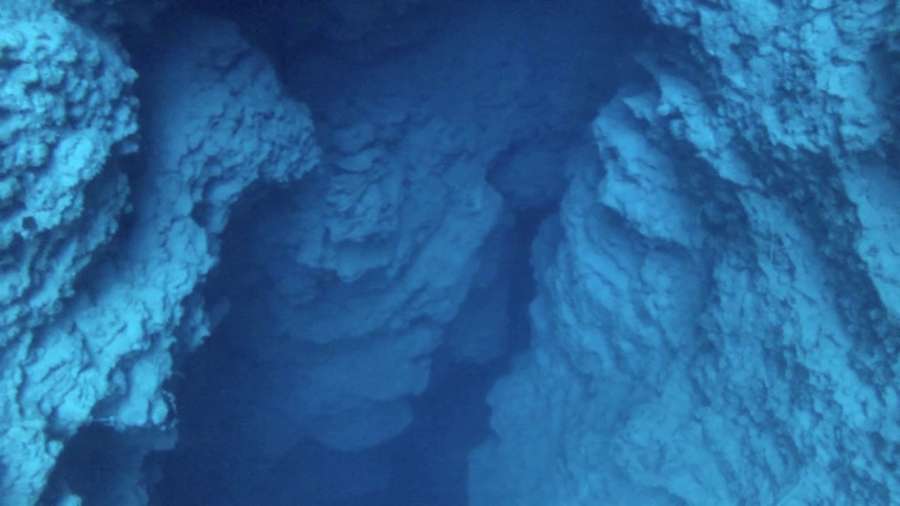Technical Advanced Trimix Diving

The Shearwater Perdix multi-gas dive computer worn by all the staff @roatan tec center.
Wondering what its like planning and diving to 100mt/333ft
Finding the right mind set to prepare for a technical advanced trimix dive to 100mts can take days, and we have to complete build up dives to reach our goal. To plan and dive to 100mt/333ft our day starts with another gallon of water consumed for breakfast….. hold the coffee for the week, it dehydrates you! The night before was spent drinking copious amounts of H2O and rest. Mind needs to be sharp as we are entering a realm of crush depth for the dive equipment we are using. Pee test in the morning, any signs of dehydration and the dive is off….. Clear pee… Alright, dive is a go! We have calculated out the ideal gas blend for that depth using our desktop decompression software (V-Planner). We need to eliminate the oxygen content as it starts to become toxic below 66mt / 218ft, (I know I can dive deeper on air and not be concerned about oxygen toxicity, but that’s a different story all together). We need to replace the nitrogen as well, after hydrogen, helium is the second lightest and second most abundant element in the observable universe, being present at about 24% of the total elemental mass, which is more than 12 times the mass of all the heavier elements combined. Whatever, put it our scuba tanks and call it Trimix, a mixture of helium, oxygen, and nitrogen. A shorten version, we are going to dive TMx 10/60, 10% oxygen, 60% helium, 29% nitrogen. I know right, 10% will not sustain life on surface, well done….. So, we need a travel gas that we can breathe on the surface and a deep deco gas. We calculate out that we will blend a TMx 18/15 as our travel gas, and not switch until we reach 1.4ata for the oxygen content, meaning our switch depth is 68mt / 223ft. With now 3 tanks on us we need decompression gases to accelerate our decompression, two most common deco gases 50/50 and 100% Oxygen. So, a total on this dive of 6 tanks that we will carry and safely switch to each regulator, because if not there’s no coming home. An instant killer in technical diving, respect your gas switches!

On surface before starting the dive we perform a full gas shutdown drill and a modified out of air drill to keep our minds sharp. Its going to take roughly 5 minutes to reach bottom with one gas switch and the way down. We are descending into a dive site called “The gateway to hell” although it looks like a stairway to heaven.

On the descent we roll through the first thermocline at 70mts / 230ft, a deep dark cold feeling rushes over you. We continue on the descent, staring into a crack in the earth that has been there since the ice age. 30mt / 100ft still on the descent, we hit the second thermocline at 88mts / 290ft. The water temp is now reading 24c / 76f, I know it’s cold to us, but still pretty warm at those depths. This is where time is now starting stand still, every breath were taking in 10 times that of the surface, the high amount of helium squeaks through the second stage. I am sitting at 100mts / 333ft, staring into the darkness and beauty of what the ocean has created in front of me. My mind is sharp analyzing all potential problems that could occur, however the high content of it is making me slightly light headed. A feeling one could not describe to a person that has never felt the deep like this.

One minute warning before the long ascent to the surface, focus…. Situational awareness has me checking time, gas supplies, depth and ascent rates to follow. Our bottom time is up, check and record pressures, within my rule of thirds we ascend. We are know in a critical zone as we ascend up the crack monitoring an above average ascent rate. Pass through the second thermocline and a rush of warm water warms us up, we reach our switch depth and safely switch to our deep decompression gas Tmx18/15. From now on we ascend no faster than 6mts/min. Whilst decompressing in the deep waters we constantly are monitoring each other and ourselves for any unusual behavior or symptoms, to much can wrong in this portion on the dive. @ runtime 29min of the dive we have a gas switch to 50/50 mix that will start to speed up the washout of nitrogen and helium, and @ runtime 41min of the dive we switch to 100% Oxygen for an even more accelerated gas tissue washout. At the completion of the dive 60min, we signal each other that we have completed our decompression schedules and we all feel that no DCS signs or symptoms. Before ascending we need to finish off the dive with a proper ascent to the surface. An additional 2min @ 5mt/15ft, 2min @ 3mt/10ft, and 1min @ 1.5mt/5ft. Once on surface we continue to breath down our Oxygen for a safety factor.

A look at the schedule that V-Planner has created for us to follow. However we still have our multi-gas dive computers, with back ups.
Dec to 220ft (3) Trimix 18/15 60ft/min descent.
Dec to 300ft (5) Trimix 10/60 60ft/min descent.
Dec to 333ft (5) Trimix 10/60 60ft/min descent.
Level 333ft (9) Trimix 10/60 1.11ppO2, 106ft ead, 113ft end
Asc to 240ft (11) Trimix 10/60 -40ft/min ascent.
Level 240ft (12) Trimix 10/60 0.83ppO2, 71ft ead, 76ft end
Asc to 220ft (12) Trimix 18/15 -40ft/min ascent.
Stop at 220ft 0:11 (13) Trimix 18/15 1.38ppO2, 182ft ead, 182ft end
Stop at 200ft 1:00 (14) Trimix 18/15 1.27ppO2, 165ft ead, 165ft end
Stop at 180ft 1:00 (15) Trimix 18/15 1.16ppO2, 148ft ead, 148ft end
Stop at 160ft 1:00 (16) Trimix 18/15 1.05ppO2, 131ft ead, 131ft end
Stop at 150ft 1:00 (17) Trimix 18/15 1.00ppO2, 122ft ead, 123ft end
Stop at 140ft 1:00 (18) Trimix 18/15 0.94ppO2, 114ft ead, 114ft end
Stop at 130ft 1:00 (19) Trimix 18/15 0.89ppO2, 105ft ead, 106ft end
Stop at 120ft 1:00 (20) Trimix 18/15 0.83ppO2, 97ft ead, 97ft end
Stop at 110ft 1:00 (21) Trimix 18/15 0.78ppO2, 88ft ead, 89ft end
Stop at 100ft 1:00 (22) Trimix 18/15 0.72ppO2, 80ft ead, 80ft end
Stop at 90ft 1:00 (23) Trimix 18/15 0.67ppO2, 71ft ead, 72ft end
Stop at 80ft 2:00 (25) Trimix 18/15 0.62ppO2, 63ft ead, 63ft end
Stop at 70ft 4:00 (29) Nitrox 50 1.56ppO2, 32ft ead
Stop at 60ft 1:00 (30) Nitrox 50 1.41ppO2, 26ft ead
Stop at 50ft 2:00 (32) Nitrox 50 1.26ppO2, 20ft ead
Stop at 40ft 4:00 (36) Nitrox 50 1.10ppO2, 13ft ead
Stop at 30ft 5:00 (41) Nitrox 50 0.95ppO2, 7ft ead
Stop at 20ft 3:00 (44) Oxygen 1.60ppO2, 0ft ead
Stop at 15ft 15:00 (59) Oxygen 1.45ppO2, 0ft ead
Surface (59) Oxygen -20ft/min ascent.
— lost gas–> These tables are brought down as a back up for a lost gas situation, the diver would have to be alone to follow these tables, you learn more about this in the deep air courses.
OK 50 100 18/15
333 (9) (9) (9) (9)
240 (12) (12) (12) (12)
220 0 (13) 0 (13) 0 (13) 0 (13)
200 1 (14) 1 (14) 1 (14) 2 (15)
180 1 (15) 1 (15) 1 (15) 3 (18)
160 1 (16) 1 (16) 1 (16) 1 (19)
150 1 (17) 1 (17) 1 (17) 2 (21)
140 1 (18) 1 (18) 1 (18) 1 (22)
130 1 (19) 1 (19) 1 (19) 2 (24)
120 1 (20) 1 (20) 1 (20) 3 (27)
110 1 (21) 1 (21) 1 (21) 3 (30)
100 1 (22) 1 (22) 1 (22) 3 (33)
90 1 (23) 1 (23) 1 (23) 4 (37)
80 2 (25) 2 (25) 2 (25) 5 (42)
70 4 (29) 3 (28) 4 (29) 5 (47)
60 1 (30) 3 (31) 1 (30) 1 (48)
50 2 (32) 5 (36) 2 (32) 4 (52)
40 4 (36) 7 (43) 4 (36) 6 (58)
30 5 (41) 10 (53) 5 (41) 8 (66)
20 3 (44) 4 (57) 4 (45) 5 (71)
15 15 (59) 16 (73) 21 (66) 24 (95)
These are tables we need to take in case the dive went too deep or too long.
333, 9 333, 12 336, 9 336, 12
(9) (12) (9) (12)
(12) (15) (12) (15)
240 0 (16) 0 (16)
220 0 (13) 1 (17) 0 (13) 1 (17)
200 1 (14) 1 (18) 1 (14) 1 (18)
180 1 (15) 1 (19) 1 (15) 1 (19)
160 1 (16) 1 (20) 1 (16) 1 (20)
150 1 (17) 1 (21) 1 (17) 1 (21)
140 1 (18) 1 (22) 1 (18) 1 (22)
130 1 (19) 1 (23) 1 (19) 1 (23)
120 1 (20) 1 (24) 1 (20) 1 (24)
110 1 (21) 1 (25) 1 (21) 1 (25)
100 1 (22) 2 (27) 1 (22) 2 (27)
90 1 (23) 2 (29) 1 (23) 2 (29)
80 2 (25) 3 (32) 2 (25) 3 (32)
70 4 (29) 4 (36) 4 (29) 4 (36)
60 1 (30) 1 (37) 1 (30) 1 (37)
50 2 (32) 4 (41) 2 (32) 4 (41)
40 4 (36) 5 (46) 4 (36) 5 (46)
30 5 (41) 8 (54) 5 (41) 8 (54)
20 3 (44) 4 (58) 3 (44) 4 (58)
15 15 (59) 21 (79) 15 (59) 21 (79)
Wondering what its lik planning and diving to 100mt/333ft TDI Advanced trimix with Roatan Tec Center and Coconut Tree Divers in Roatan, Honduras.Respecting deep diving comes with experience and training, I tell my students “anyone can deep dive, that’s the easy part, however it’s the smart divers that come home alive”. Diving deep on a single tank with no planning or redundancies is just down right dangerous, get the training and enjoy your deep dive career.
